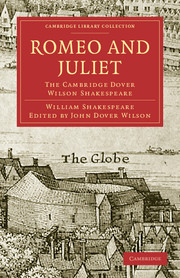THE STAGE HISTORY
Published online by Cambridge University Press: 07 September 2010
Summary
This play has probably been the most popular after Hamlet of all Shakespeare's plays on the English stage, and anything approaching a full chronicle is impossible in a short space.
The title-pages of all the three extant Quartos (1597, 1599, and 1609) speak of many performances by Shakespeare's Company, described as the Lord of Hunsdon's (Q1), the Lord Chamberlain's (Q2), and ‘the Kings Maiesties Seruants’ (Q3), adding ‘at the Globe’. Its popularity, affirmed by Q 1's ‘with great applause’, is attested by the frequent allusions in literature, from Marston's Scourge of Villany, 1598, through John Weever's Epigrams, 1599, and The Return from Parnassus, Part I (?1599), in which a character's misquotation of 2. 4. 41 is hailed as ‘Romeo and Juliet’, to L. Digges's memorial verses in F1, which declares it ‘impossible’ for ‘some new strain t'outdo | Passions of Juliet and Romeo’. Yet no actual record of performances before the Restoration survives; it is therefore impossible to say how long its vogue lasted before the closing of the theatres in 1642.
At the Restoration a warrant of the Lord Chamberlain of 12 December 1660 gave exclusive acting rights in the play to D'Avenant's Company. They performed it first on 1 March 1662, when Pepys thought it ‘a play of itself the worst that ever I heard, and the worst acted that ever I saw these people do’.
- Type
- Chapter
- Information
- Romeo and JulietThe Cambridge Dover Wilson Shakespeare, pp. xxxviii - liiPublisher: Cambridge University PressPrint publication year: 2009First published in: 1955



